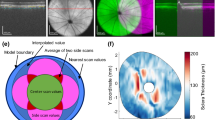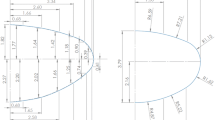Abstract
A simplified mathematical model for the eye is proposed. This idealized model simulates the aquaous flow and intraocular pressure behavior of the human eye. Starting from elementary concepts in elasticity and fluid mechanics, one can derive differential equations governing the behavior of the mathematical model. When integrated, these equations yield algebraic relationships which are closely related to some of the widely used empirical formulae in ophthalmology, e.g., Friedenwald's (1948) formula for the scleral rigidity coefficient and Grant's (1950) equation for the facility of aqueous outflow. The eye's intraocular pressure variations are simply related to its aqueous and blood volume changes if one assumes that ocular tissue has essentially linear elastic properties. St. Helen's and McEwen's (1961) experiments indicate that a linear approximation is reasonably accurate if the standard Hookian stress strain law is modified to take into account the anelastic or time-dependent elastic behavior of the corneo-scleral membrane. The last part of the paper discusses transient phenomena in an externally disturbed eye, e.g., when a tonometer is applied. One important result is a theoretical equation to describe the mean curve that one records in a tonographic tracing. This paper represents the first attempt to formulate a mathematical model relating the over-all elastic and fluid mechanical behavior of the eye. It is hoped that the model will stimulate interst and prove useful to the medical profession in motivating future experiments and in suggesting improvements for existing empirical formulae.
Similar content being viewed by others
Literature
Bárány, E. H. 1951. “Rate of Flow of Aqueous Humour in Normal and Scorbutic Guinea Pigs.”A.M.A. Arch. Ophthal.,46, 326–336.
Becker, B. and J. S. Friedenwald. 1953. “Clinical Aqueous Outflow.”A.M.A. Arch. Ophthal.,50, 557–571.
Becker, B. 1957. “The Bicarbonate Concentration of Guinea-Pig Aqueous Humour. Effect of Scurvy and Acetazolamide.”Amer. J. Ophthal.,44, 402–408.
Cole, D. F. 1959. “Some Effects of Decreased Plasma Sodium Concentration of the Composition and Tension of the Aqueous Humour.”Brit. J. Ophthal.,43, 268–287.
Davson, H. 1962a.The Eye. New York: Academic Press, Vol. I, p. 164.
—. 1962b. —Ibid.,, Vol. I, p. 78.
— 1962c. —Ibid.,, Vol. I, p. 82.
Friedenwald, J. S. 1948. “Some Problems in the Calibration of Tonometers.”Amer. J. Ophthal.,31, 935–944.
Grant, W. M. 1950. “Tonographic Method for Measuring the Facility and Rate of Aqueous Outflow in Human Eyes.”Arch. Ophthal.,44, 204–214.
Grant, W. M. 1958. “Further Studies on Facility of Flow Through the Trabecular Meshwork.”A.M. A. Arch. Ophthal.,60, 523–533.
Köllner. 1916. “Ü. d. Regelmässigen Täglichen Schwangungen des Augendrucks und ihre Ursache.”Arch. Augenheilk.,81, 120–142.
Langham, M. E. 1959. “Influence of Intraocular Pressure on the Formation of Aqueous Humour.”Brit. J. Opthal.,41, 65–92.
Levene, R. Z. 1958. “Osmolarity in the Normal State and Following Acetazolamide.”A.M.A. Arch. Ophthal.,59, 597–602.
Leydhecker, W., K. Akiyama, and H. G. Neumann. 1958. “Der Intraokulare Druck gesunder menschlicker Augen.”Klin. Mbl. Augenheilk.,133, 662–670.
Macri, F. J., T. Wanko and P. A. Grimes. 1958. “The Elastic Properties of the Human Eye.”A.M.A. Arch. Ophthal.,60, 1021–1026.
Maurice, D. M. 1958. “A Recording Tonometer.”Brit. J. Ophthal.,42, 331–335.
McBain, E. H. 1958. “Tonometer Calibration. II: Ocular Rigidity.”A.M.A. Arch. Ophthal.,60, 1080–1091.
Pappas, G. D. and G. K. Smelser. 1958. “Studies of the Ciliary Epithelium and the Zonule.”Amer. J. Ophthal.,46, Pt. II, 299–318.
Pease, D. C. 1956. “Infolded Basal Plasma Membranes Found in Epithelia Noted for their Water Transport.”J. biophys. biochem. Cytol.,2, Suppl. 203–208.
Perkins, E. S. 1957. “Influence of the Fifth Cranial Nerve on the Intraocular Pressure of the Rabbit Eye.”Brit. J. Ophthal.,41, 257–300.
Ridge, J. W. 1955. “Sodium and Chloride of the Aqueous Humour of the Normal and Scorbutic Guinea Pigs.”Brit. J. Ophthal.,39, 534–539.
St. Helen, R., and W. K. McEwen. 1961. “Rheology of the Human Sclera.”Amer. J. Ophthal.,52, 539–548.
Sokolnikoff, I. S. 1956.Mathematical Theory of Elasticity. New York: McGraw-Hill, 177–184.
Weigelin, E., and H. Löhlein. 1952. “Blutdruckmessungen an den Episkleralen Gefässen des Auges bei Kreislaufgesund Personen.”v. Graefes Arch. Ophthal.,153, 202–213.
Author information
Authors and Affiliations
Rights and permissions
About this article
Cite this article
Weinbaum, S. A mathematical model for the elastic and fluid mechanical behavior of the human eye. Bulletin of Mathematical Biophysics 27, 325–354 (1965). https://doi.org/10.1007/BF02478410
Issue Date:
DOI: https://doi.org/10.1007/BF02478410




